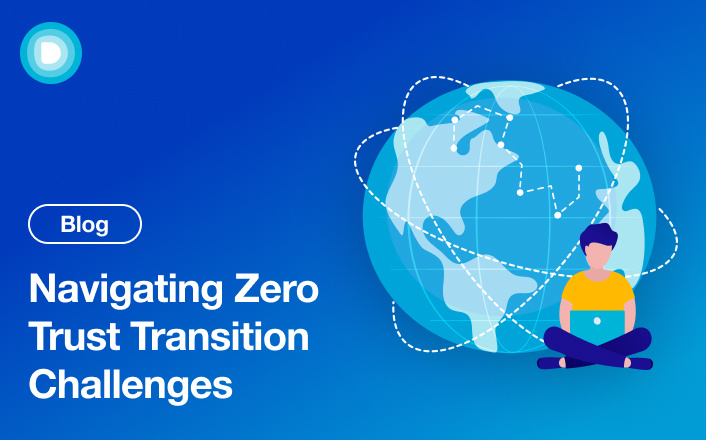- Product
-
Solution
-
By Industry
Cybersecurity solutions tailored to your industry’s needs.
-
- Resources
-
Books
Our ultimate guides and playbooks
Solution Briefs
Overview of PureDome’s functionality
-
Quizzes
Assess your cybersecurity readiness
Case Studies
PureDome customer success stories
Newsletter
Subscribe to the PureDome newsletter
-
- About Us
- Partner
- Pricing
- Download
Navigating Resistance: Strategies for a Smooth Transition to Zero Trust Cybersecurity
-
Sharmeen Saleem
-
02 May 2024
- 5 min read


In the hybrid working world, effective business collaboration demands a more agile approach to your organization’s cyber security. Consequently, Zero Trust security architecture has gained momentum and attention in the post-pandemic era. Implementing Zero Trust isn't just about technology; it's also a business and cultural transformation dependent on ethos, communications, and awareness.
As you embark on your Zero Trust journey, adopting a human-centered approach is crucial to developing a compelling cyber-centric future. Zero Trust is about removing implicit trust and evaluating each connection request based on factors such as authenticated and authorized users and other contextual signals like device posture and geolocation. To ensure adoption by your employees, your Zero Trust implementation should prioritize building a strong employer-employee relationship to mitigate the risks of resistance and business disruption.
The Roadblocks to Zero-Trust Adoption
Transitioning to zero-trust network architecture (ZTNA) represents a significant transformational process for organizations, with the process gaining complexity as the organization's size increases. Despite the multitude of advantages ZTNA offers, achieving full implementation poses several challenges.

Let's explore some of them here:
Legacy Systems and Zero Trust:
- Shifting from Implicit Trust to Adaptive Trust: Traditional legacy systems typically operate under "implicit trust," granting access and authorization based on fixed attributes. This contrasts with the core principle of Zero Trust Architecture (ZTA), which prioritizes the adaptive evaluation of trust. Transitioning from a system built on inherent trust to one that continually assesses trust levels represents a significant paradigm shift.
- Investment in Modernization: Legacy infrastructures grounded in implicit trust necessitate substantial investments to align with zero-trust principles. This entails more than just financial investments; it requires dedicated time, specialized skills, and unwavering organizational commitment.
Stakeholder Engagement:
- Securing Broad-Based Buy-In: Successful adoption of zero trust hinges on active engagement and collaboration among diverse stakeholders, including management, IT personnel, data/system owners, and end users. Ensuring comprehensive buy-in and sustained commitment across all levels is paramount.
- Transitioning from Siloed IT Services: Historically, many organizations have operated with compartmentalized IT services. Embracing Zero Trust Architecture (ZTA) necessitates a shift towards a more unified and cooperative approach, with widespread acceptance of shared architecture and governance policies.
Technological Landscape:
- Keeping Pace with Evolving Technology: The rapid advancement of technology continually introduces new solutions and strategies. Organizations must remain agile and adaptable to ensure their zero-trust initiatives remain relevant and feasible.
- Navigating Cloud Technologies: The proliferation of cloud technologies offers both opportunities and challenges. While cloud platforms can provide more agile and scalable solutions, they also introduce complexities in terms of security and compliance.
The challenges associated with zero trust adoption are indeed significant, but they are not insurmountable. With a well-defined strategy, comprehensive stakeholder engagement, and a commitment to ongoing learning and adaptation, you can effectively address these challenges and establish a resilient zero-trust environment.
Evaluating Organizational Readiness for Zero Trust Implementation
Transitioning to a new architectural strategy is a substantial effort that demands meticulous planning and consideration of organizational dynamics. This segment emphasizes critical organizational readiness factors for Zero Trust implementation within the enterprise. By addressing these factors, your organization can lay the groundwork for a more robust and effective security posture.

Skill Enhancement and Training
Once leadership alignment is achieved and communication channels are established, it becomes imperative to enhance the skills and knowledge of employees tasked with implementing Zero Trust. This involves familiarizing them with Zero Trust principles, instructing them on their application in their respective roles, and training them to respond effectively to security incidents. Provide comprehensive training and development opportunities for employees to acquire these essential skills.
Cloud Competence
Evaluate your organization's proficiency in cloud technologies and Zero Trust principles to identify any skill gaps you may have. Take part in training and development programs to enhance your competencies and equip yourself with the necessary expertise to excel in a cloud-driven and zero-trust environment. Embrace a culture of continuous learning to keep up with evolving technologies and security practices.
Security Awareness
Assess your organization's security culture and gauge your team's awareness levels regarding security best practices and adherence to procedures and policies and procedures. Identify any shortcomings in security knowledge and consider conducting security awareness training programs to educate your team on the significance of Zero Trust and their roles in ensuring a secure environment.
Alignment and Communication at the Leadership Level
Ensure that you achieve alignment and effective communication among your leadership team, as these are crucial elements for the successful rollout of Zero Trust. It's imperative to grasp the advantages of Zero Trust and understand the necessary resources. Additionally, be prepared to instigate cultural and procedural changes within your organization. Transparent communication with your employees is vital for fostering trust and garnering support. Your employees should comprehend the rationale behind Zero Trust implementation, its implications, and how they can contribute. Ensure that communication channels remain open, transparent, and continuous.
Support and Buy-In from Leadership
To effectively implement a Zero Trust Architecture (ZTA), it's paramount that you align key stakeholders and executives on the architecture's objectives, benefits, and success metrics. Emphasize the significance of Zero Trust principles in bolstering security and facilitating business agility by transitioning from traditional perimeter-based security to a more personalized, user-centric approach. Adopting this approach enables your organization to adapt swiftly to evolving threats and changes. Executive alignment sets the organizational tone and aids in overcoming potential resistance to change.
Transparent Communication with Employees
Maintain transparent and open communication with your employees during the Zero Trust implementation process. Clearly articulate the adoption's rationale, advantages, and anticipated outcomes and promptly address any concerns. Provide regular updates on the implementation's progress to enhance buy-in, minimize resistance, and foster trust.
Organizational Structure and Roles
For a successful implementation of Zero Trust, it's essential to establish an effective organizational structure and define roles accordingly. This involves setting up a Cloud Center of Excellence (CCoE), reassessing and adjusting security operations, and assigning roles and responsibilities for vulnerability management, incident response, and security monitoring.
Security Operations
To align with the requirements of a Zero Trust environment, it's imperative to evaluate and adjust your existing security operations structure. Consider enhancing monitoring, incident response, and threat intelligence capabilities by implementing Security Operations Centers (SOCs) or engaging Managed Security Service Providers (MSSPs). Clearly define roles and responsibilities for vulnerability management, incident response, and security monitoring. A robust incident response process is essential for promptly detecting and addressing minor security incidents, preventing escalation into more significant issues. This proactive approach helps mitigate risks and safeguards against potential disruptions.
Cloud Center of Excellence
You should create a CCoE to provide guidance, share best practices, and ensure oversight of your cloud operations. This team, comprising individuals from various business units and IT teams, will be responsible for developing and implementing cloud-related best practices, guidelines, and governance policies. By fostering collaboration and alignment across different departments, the CCoE is pivotal in integrating Zero Trust principles into your cloud-hosted workloads and promoting knowledge sharing throughout your organization.
Monitoring and Assessment
For successful Zero Trust implementation, your organization must continually monitor and assess its security posture. This involves establishing key performance indicators (KPIs), monitoring and evaluating these KPIs, and fostering a culture of continuous improvement. By following these steps, organizations can ensure the effectiveness of their Zero Trust implementation and continuously strive for enhanced security.
Continuous Improvement
Implement mechanisms to solicit stakeholder feedback and insights, fostering a continuous improvement culture. Encourage staff members to share ideas and suggestions for enhancing the cloud environment's security, efficiency, and user experience. Utilize this feedback to streamline processes, improve security measures, and drive innovation.
Key Performance Indicators
Establish relevant key performance indicators (KPIs) to measure the success and efficiency of your Zero Trust deployment. These KPIs may include user satisfaction, progress in equipment and rollout, cost reduction, compliance adherence, and the frequency of security incidents. Regularly monitor and evaluate these KPIs to track overall progress and identify opportunities for improvement.
The Human Element: Readiness for Change in Cybersecurity
Change management is essential for organizations as they integrate new technology and processes into their infrastructure. However, the human dimension of cybersecurity often goes unnoticed during this transition. As a cybersecurity professional, maintaining a constant state of readiness is crucial before implementing any requested changes.
Incorporating a zero-trust approach to cybersecurity is vital for preserving security, particularly when integrating cloud services into your infrastructure. Before utilizing cloud services, it's essential to establish robust security controls and evaluate their potential impact on your security posture.
Effective change management practices involve identifying potential security risks, assessing their implications, and devising mitigation plans in collaboration with relevant stakeholders. Communicating potential risks to stakeholders throughout the change process is imperative for maintaining transparency and accountability.

Wrapping Up
As you consider the potential of integrating a Zero Trust security strategy into your organization, it's crucial to strike a balance. While adopting Zero Trust may represent a significant change for your organization, approaching this transformation with a human-centered mindset is critical. When implementing Zero Trust architecture, you should carefully define the project's branding from the outset. A culture that prioritizes security, focuses on open communication, and champions awareness campaigns are essential to help your employees understand that Zero Trust is a commitment to their safety, security, and flexibility, as well as to ease the transition.